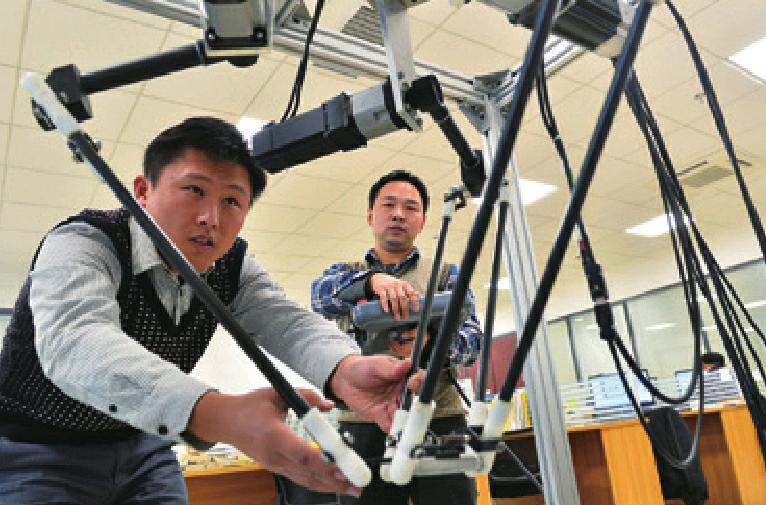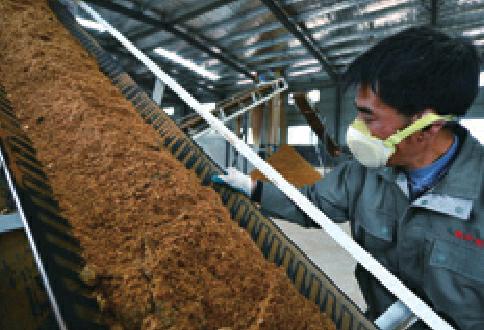Race Against Time
2015-12-14
Rescuers search for survivors in a collapsed house after a landslide hit Lidong Village of Lishui City, Zhejiang Province, on November 13.
The death toll from the disaster had reached 36 as of November 18. More than 300 affected villagers have been relocated.
Electricity Access
Nearly 1 million rural residents in Xinjiang Uygur Autonomous Region have gained access to electricity in the past five years, the regional energy authorities said on November 13.
The State Grid Corp. of Chinas Xinjiang branch has invested 17.08 billion yuan ($2.68 billion) since 2011 in 1,889 projects that helped to provide electricity to a total of 984,100 people in 81 counties, the company said.
According to the company, it will continue to invest another 40.8 billion yuan ($6.39 billion) in power grid construction in rural areas in the next five years. As a result, rural per-capita electricity consumption is expected to be raised to 1,204 kwh in 2020 from 738 kwh in 2014.
The companys news officer Li Yifeng said that the remaining 100,000 people who have no access to electricity will be able to utilize electric power via independent photovoltaic panels by year end.
All Against Smog
Air pollution forecasts for six cities in the Beijing-Tianjin-Hebei region are likely to be taken as a whole when emergency responses are being considered, said a plan released on November 17.
According to a meeting attended by environment officials from Beijing, Tianjin as well as Baoding, Cangzhou, Langfang and Tangshan in Hebei Province, consultation and synchronization will be tried among the six cities before being expanded to include the whole region.
The plan, currently out for public feedback, says that all the six cities should initiate the highest level of emergency measures when high pollution levels are forecast in at least four of them for the subsequent four days.
Green Campaign
China has designated June of each year National Ecological Civilization Month as it plans a campaign to encourage the public to lead green lifestyles.
In a circular on its website on November 16, the Ministry of Environmental Protection urged environmental protection authorities across the country to promote environmentally friendly practices in supply, packaging, procurement, recycling, dining, clothing, housing and traveling.
The ministry promised policies and regulations in support of the campaign, and said it will nominate cities to pilot green schemes.
Li-Fi Technology
A new Chinese breakthrough in visible light communication (VLC) technology may enable people to download a HD Hollywood movie in around 0.3 seconds simply using the light of a lamp.
A test conducted by the Ministry of Industry and Information Technology confirmed that the realtime traffic rate of a Chinese VLC system had reached 50 gigabits per second (Gbps), the ministry announced on November 13.
The real-time speed is the highest obtained by China so far. In August 2014, media reported a group of Mexican scientists used similar technology to transmit data with speeds up to 10 Gbps.
The VLC system was developed by the Peoples Liberation Army Information Engineering University and has entered a phase of “integration and micromation in design.” The university succeeded in developing a wireless broadcasting system based on VLC in 2013.
Grottoes Go Digital
Chinese researchers are taking digital inventory of a collection of ancient sculptures and artwork at the Maijishan Grottoes in northwest Chinas Gansu Province, local relics protection authorities said.
The Maijishan Grottoes, translated as Wheat Stack Hill, is a 1,500-year-old UNESCO World Heritage site home to 10,632 Buddhist sculptures in 221 grottoes.
Sun Xiaofeng, a researcher with the Art Institute of Maijishan Grottoes, said that preparation for the digital archive began in 2010.
“The work has proceeded slowly as images are hard to collect from the sculptures, most of which are located in narrow spaces on the cave walls,” said Sun. Digital mapping work has been completed in 50 caves by far, and 170 others remain to be finished.
Animal Welfare
Chinese veterinarians have started drafting the countrys first welfare standard for the farming and slaughter of livestock and poultry, according to the Chinese Veterinary Medical Association (CVMA).
The CVMA will partner with about 30 leading businesses in farming, slaughtering, food processing and food services. The standard will involve living conditions, disease control and procedures before slaughtering.
While not compulsory, it will be the first industry welfare standard for livestock in China and will cover pigs, chicken, sheep and cattle.
The standard will be published by the association in June 2016. Within about two years, it is expected to be revised and receive the governments recommendation.
Seeing Is Believing
A woman tries 3,300-ppi portable cinema system in the 17th China Hi-Tech Fair, which kicked off in Shenzhen, Guangdong Province, on November 16.
The event covers an exhibition area of more than 150,000 square meters with over 3,000 exhibitors from 28 countries and regions.
Quake Monitoring
Chinas earthquake and geo-information authorities on November 18 signed a deal to share data, strengthening their capabilities in earthquake prevention and relief.
Under the deal, the China Earthquake Administration (CEA) and the National Administration of Surveying, Mapping and Geoinformation will regularly exchange data including from the Global Navigation Satellite System, gravitational observation, observation of magnetic fields, mapping of geological formations and topography and remote sensing.
They also agreed to launch gravitational surveillance in Tibet Autonomous Region, filling a void for such statistics in the region, and to use the China-managed Beidou Navigation Satellite System and gravitation satellites in quake prevention and disaster reduction.
The value of the two departments cooperation has already been demonstrated by their effective sharing of remote sensing and other observation data to help with relief following the Wenchuan and Yushu earthquakes in 2008 and 2010, said CEA head Chen Jianmin.
Tomb Findings
Chinese archaeologists claimed on November 14 to have unearthed a portrait of Confucius from a tomb that is at least 2,000 years old.
After they pieced together a broken lacquer screen found in the main chamber of the tomb, the archaeologists said that they restored two portraits, one of which is believed to be of Confucius.
“The Chinese characters on the screen include the names of Confucius, his father, Shu Lianghe, and one of his favorite disciples, Yan Hui,” said Zhang Zhongli, deputy chief of the excavation team in east Chinas Jiangxi Province. “These names are evidence that at least one of the two men painted on the screen is Confucius himself.”
Role Model
Glen Walter, CEO of Coca-Cola Bottling Investments Group China, delivers a speech to students of Chongqing Technology and Business University in the southwestern municipality on November 18.
The lecture was part of an entrepreneurship education program launched by the university, which invites business leaders to share their experiences.

Clean Plateau
The Tibetan Plateau remains one of the worlds cleanest regions despite the lingering presence of pollutants from farming and mining, according to research released on November 18.
The pollutant levels recorded on the plateau are similar to those seen across the Arctic and remain remarkably lower than densely populated areas, according to an environment change evaluation report issued by the Institute of Tibetan Plateau Research under the Chinese Academy of Sciences, which featured research from scientists from around the world.
Airborne pollutants on the plateau have increased by 200 percent since the 1950s, according to the report. However, both black carbon, a climate forcing agent that heats up the atmosphere and warms the earth, and persistent organic pollutants remain at relatively low levels that are close to or lower than in the Arctic or the Alps.
Tax Break
Chinese firms received 237.5 billion yuan ($37.2 billlion) worth of tax cuts in the first three quarters of this year thanks to government policies designed to spur innovation and mass entrepreneurship, the State Administration of Taxation said on November 19.
Millions of businesses have seen their taxes reduced.
In the first three quarters, the government slashed the corporate income tax rate from 25 percent to 15 percent, which gave hi-tech companies a 96.5-billion-yuan($15.12-billion) tax break.
Tax exemptions and breaks on small enterprises reached 73.3 billion yuan ($11.5 billion). Tax cuts designed to encourage spending on research and development totaled 44.4 billion yuan ($6.96 billion).
Industries related to the transfer of technology and commercialization also saw billions of yuan worth of tax breaks.
In the face of economic headwinds, China is counting on entrepreneurship and innovation to generate new jobs and improve its citizens skill sets, in addition to firing up a slowing economy.
During an executive meeting in October, the State Council decided to further optimize its preferential tax policies for firms engaged in research and development in 2016.
Housing Market
The recovery of Chinas real estate sector slowed in October as fewer cities reported price increases, mainly because of a continuing oversupply of homes.
New home prices rose monthon-month in 27 of the 70 large and medium-sized cities surveyed in October, according to statistics released by the National Bureau of Statistics (NBS) on November 18. Meanwhile, 33 cities reported a month-on-month decline in prices.
On a yearly basis, Chinas housing market continued to warm in October, with 16 cities posting new home price increases.
New home prices surged 40.5 percent year-on-year in Shenzhen in south Chinas Guangdong Province in October, the sharpest increase among the countrys major cities.
“Trends in Chinese real estate have diverged notably,” NBS statistician Liu Jianwei said.
Home prices in top-tier cities, where demand is high, saw strong growth. In second-tier cities, prices staged mixed performances, while they continued to drop in third-tier cities.
Online Bank
Chinas search engine giant Baidu and financial service company CITIC Group announced on November 18 they would open an online bank.
Baixin Bank, a direct sales bank that provides online financial services, will be Chinas first venture between an Internet company and a traditional bank.
The new bank will have 2 billion yuan ($313.5 million) in registered capital. CITIC Bank, a subsidiary of CITIC group, will be the controlling shareholder, according to a CITIC Bank statement.
Baidus archrivals—Alibaba and Tencent—have already secured banking licenses and started to explore the banking sector. Tencent launched its online bank, WeBank, in January, which it has a 30-percent stake in. Alibaba owns 30 percent of MYbank, which opened in June, through Ant Financial.
Hi-Tech Incubator
A technician develops a parallel robot in a robotic company located in the Technological Innovation Service Center in Shijiazhuang, capital of north Chinas Hebei Province.
The service center, which opened in 2009, has incubated 214 small and micro businesses in the hi-tech industry.
Anti-Dumping Probe
Chinas Ministry of Commerce(MOFCOM) began an anti-dumping investigation over a kind of ironbased alloy imported from the United States and Japan.
The MOFCOM will try to determine whether the imports—an iron-based amorphous alloy ribbon (strip), which was allegedly at“lower than normal” prices—have damaged or impacted domestic producers interests.
The investigation started on November 18.
Iron-based amorphous alloy ribbon is widely used in manufactur-ing power distribution transformers, electric reactors, motors and voltage transformers.
Foreign Investment
Foreign direct investment (FDI) into the Chinese mainland rose 4.2 percent year-on-year to $8.77 billion in October, the MOFCOM said on November 18. Non-financial FDI for the first 10 months stood at $103.7 billion, up 8.6 percent from the same period last year.
Foreign investment in the hitech service sector saw a jump of 57.5 percent to $6.76 billion.
Hi-tech manufacturing attracted$7.58 billion of foreign investment during the January-October period, up 11.6 percent and accounting for 23.3 percent of total foreign investment in manufacturing.
On the other side of the equation, Chinas outbound direct investment (ODI) in non-financial sectors surged 16.3 percent year-onyear during the first 10 months of the year.
ODI from the Chinese mainland companies totaled $95.21 billion during the period, covering 5,553 companies across 152 countries and regions, according to the MOFCOM. ODI projects cover a wide range of fields, including transportation, residential construction, electric power engineering, telecommunication and petrochemical industries.
Clean Energy
Shredded waste from farmland and forests is put into a drying machine in a biological energy company in Enshi, central Chinas Hubei Province. The end product is a clean source of energy that can be used for heating.
Stock Connect
Shanghai-Hong Kong Stock Connect has operated steadily since its launch a year ago.
Shanghai stocks have attracted 121 billion yuan ($19.73 billion) through this investment channel, about 40 percent of the 300-billionyuan (47.04-billion-dollar) aggregate quota, and the investment produced a trade volume of 1.538 trillion yuan ($241.16 billion), according to the Shanghai Stock Exchange.
Hong Kong stocks have attracted 92.4 billion yuan ($14.49 billion) through the program, about 37 percent of the 250-billion-yuan(39.2-billion-dollar) annual quota, and the investment produced a trade volume of 742 billion Hong Kong dollars ($95.74 billion), according to Hong Kong Exchanges and Clearing Limited (HKEx).
“But the focus should not be on aggregate quota usage or trading turnover, because Stock Connect is much bigger than that: Its a catalyst and a model for the future,” said Charles Li Xiaojia, CEO of HKEx, on the first anniversary of the program.“It unlocked a door to the Chinese mainland, and in future will likely be seen as the precursor to a new generation of cross-border regulatory cooperation and market connections,” he added.
“Shanghai-HK Stock Connect provided a model that can be copied in the future for the internationalization of the Chinese capital market,”said Huang Hongyuan, General Manager of the Shanghai Stock Exchange.
RQFII Quota
China will raise the investment quota for Singapore under the RMB Qualified Foreign Institutional Investors (RQFII) scheme from 50 billion yuan($7.84 billion) to 100 billion yuan ($15.7 billion), the PBOC announced on November 17.
The RQFII mechanism, which was launched in December 2011 to widen investment channels for overseas yuan funds on the Chinese mainland, allows qualified investors to invest yuan-based funds in the mainland securities market within a permitted quota.
The decision is part of deepening financial cooperation between the two countries, which will offer diversified investment products for Singaporean investors while pushing Chinas capital market to open wider, the central bank said
Stronger and Faster
A bullet train is on a test run in east Chinas Shandong Province. Bullet trains independently developed by China passed the threshold speed of 350 km per hour on November 18.
